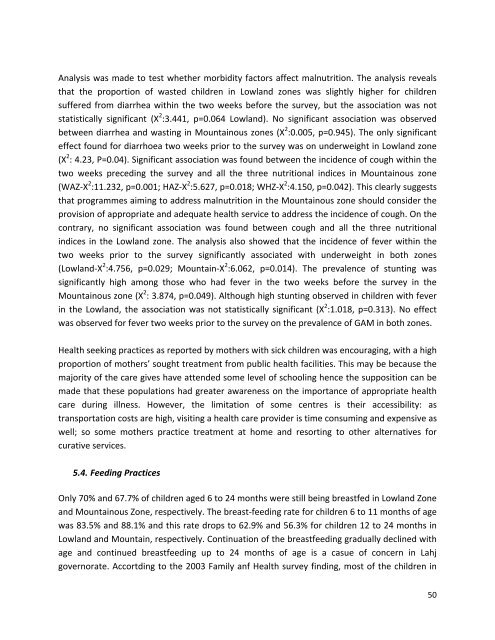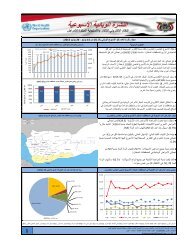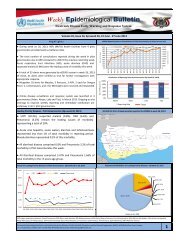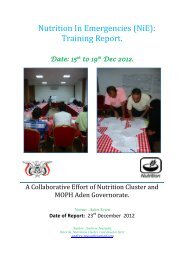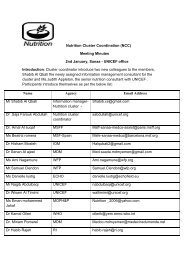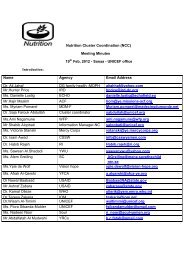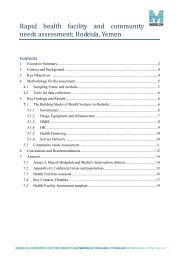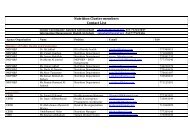Download - Yemen Humanitarian Response | YEMEN
Download - Yemen Humanitarian Response | YEMEN
Download - Yemen Humanitarian Response | YEMEN
You also want an ePaper? Increase the reach of your titles
YUMPU automatically turns print PDFs into web optimized ePapers that Google loves.
Analysis was made to test whether morbidity factors affect malnutrition. The analysis revealsthat the proportion of wasted children in Lowland zones was slightly higher for childrensuffered from diarrhea within the two weeks before the survey, but the association was notstatistically significant (X 2 :3.441, p=0.064 Lowland). No significant association was observedbetween diarrhea and wasting in Mountainous zones (X 2 :0.005, p=0.945). The only significanteffect found for diarrhoea two weeks prior to the survey was on underweight in Lowland zone(X 2 : 4.23, P=0.04). Significant association was found between the incidence of cough within thetwo weeks preceding the survey and all the three nutritional indices in Mountainous zone(WAZ-X 2 :11.232, p=0.001; HAZ-X 2 :5.627, p=0.018; WHZ-X 2 :4.150, p=0.042). This clearly suggeststhat programmes aiming to address malnutrition in the Mountainous zone should consider theprovision of appropriate and adequate health service to address the incidence of cough. On thecontrary, no significant association was found between cough and all the three nutritionalindices in the Lowland zone. The analysis also showed that the incidence of fever within thetwo weeks prior to the survey significantly associated with underweight in both zones(Lowland-X 2 :4.756, p=0.029; Mountain-X 2 :6.062, p=0.014). The prevalence of stunting wassignificantly high among those who had fever in the two weeks before the survey in theMountainous zone (X 2 : 3.874, p=0.049). Although high stunting observed in children with feverin the Lowland, the association was not statistically significant (X 2 :1.018, p=0.313). No effectwas observed for fever two weeks prior to the survey on the prevalence of GAM in both zones.Health seeking practices as reported by mothers with sick children was encouraging, with a highproportion of mothers’ sought treatment from public health facilities. This may be because themajority of the care gives have attended some level of schooling hence the supposition can bemade that these populations had greater awareness on the importance of appropriate healthcare during illness. However, the limitation of some centres is their accessibility: astransportation costs are high, visiting a health care provider is time consuming and expensive aswell; so some mothers practice treatment at home and resorting to other alternatives forcurative services.5.4. Feeding PracticesOnly 70% and 67.7% of children aged 6 to 24 months were still being breastfed in Lowland Zoneand Mountainous Zone, respectively. The breast-feeding rate for children 6 to 11 months of agewas 83.5% and 88.1% and this rate drops to 62.9% and 56.3% for children 12 to 24 months inLowland and Mountain, respectively. Continuation of the breastfeeding gradually declined withage and continued breastfeeding up to 24 months of age is a casue of concern in Lahjgovernorate. Accortding to the 2003 Family anf Health survey finding, most of the children in50


